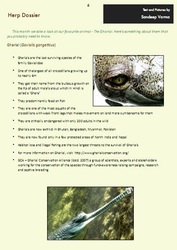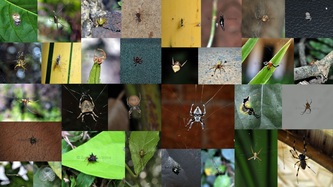Herp Dossier 6
This month we take a look at our favourite animal ‐ The Gharial. Here’s something about them that you probably need to know.
Gharial (Gavialis gangeticus)
• Gharials are the last surviving species of the family Gavialidae
• One of the largest of all crocodilians growing up to nearly 6m
•They get their name from the bulbous growth on the tip of adult male’s snout which in Hindi is
called a ‘Ghara’
• They predominantly feed on fish
•They are one of the most aquatic of the crocodilians with weak front legs that makes movement on
land more cumbersome for them
•They are critically endangered with only 200 adults in the wild
•Gharials are now extinct in Bhutan, Bangladesh, Myanmar, Pakistan
•They are now found only in a few protected areas of North India and Nepal
•Habitat loss and illegal fishing are the two largest threats to the survival of Gharials
•For more information on Gharial, visit http://www.gharialconserva9on.org/
•GCA – Gharial Conservation Alliance (Estd. 2007) a group of scientists, experts and stakeholders
working for the conservation of the species through fund‐awareness raising campaigns, research
and captive breeding
This month we take a look at our favourite animal ‐ The Gharial. Here’s something about them that you probably need to know.
Gharial (Gavialis gangeticus)
• Gharials are the last surviving species of the family Gavialidae
• One of the largest of all crocodilians growing up to nearly 6m
•They get their name from the bulbous growth on the tip of adult male’s snout which in Hindi is
called a ‘Ghara’
• They predominantly feed on fish
•They are one of the most aquatic of the crocodilians with weak front legs that makes movement on
land more cumbersome for them
•They are critically endangered with only 200 adults in the wild
•Gharials are now extinct in Bhutan, Bangladesh, Myanmar, Pakistan
•They are now found only in a few protected areas of North India and Nepal
•Habitat loss and illegal fishing are the two largest threats to the survival of Gharials
•For more information on Gharial, visit http://www.gharialconserva9on.org/
•GCA – Gharial Conservation Alliance (Estd. 2007) a group of scientists, experts and stakeholders
working for the conservation of the species through fund‐awareness raising campaigns, research
and captive breeding



 RSS Feed
RSS Feed
